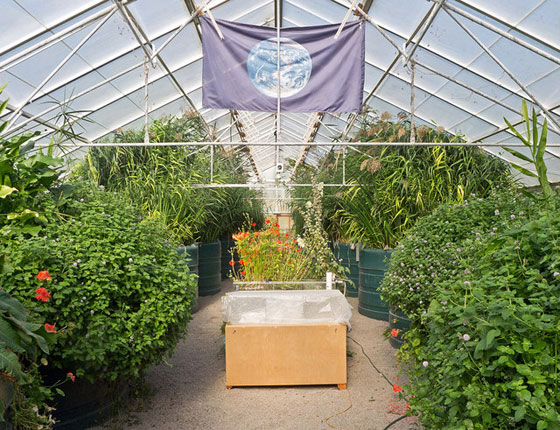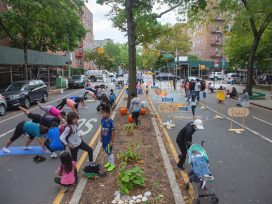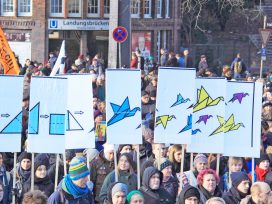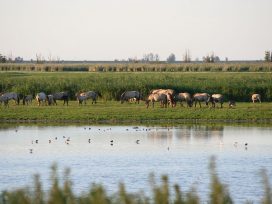Urban life requires that less land be developed for settlement and reduces traffic volumes. Moreover, commoning practices can provide products required on a daily basis at reduced cost, while using fewer resources and improving quality of life. Fred Frohofer argues for the restructuring of our cities and their relation to rural regions.
To recuperate from everyday stress, one books a hotel and packs a suitcase. There’s nothing more to it than that, everything is provided: a room as a safe haven; a restaurant, a bar and table football or pool tables where one can socialize for example; a pool or lake in which to swim, where one can let one’s thoughts run free. And everything can be reached by foot. What more would you want? So say some creatives and celebrities who live permanently in hotels.
The Chelsea Hotel in Manhattan was probably the most famous and talked about residence for long-term guests. Though it’s currently being renovated and upgraded, the hotel’s past splendour is not about to return: it was once the inspiring home of extraordinary people such as Stanley Kubrick, Janis Joplin, Arthur Miller, Patty Smith or Bob Dylan.
But why the disproportionately huge houses for a single family, why the need for misconceived apartments in dreary agglomerations, if we can go to a hotel in order to recharge our batteries in our free time; if we find everything there that we need? Is it a question of price? Hotels are only expensive if one uses their services: if guests were at the same time employees of the hotel, then the resulting infrastructure would be comparable to that of a hotel but even cheaper that our current forms of accommodation; many problems would finally be solved.
At this point, we already become entangled with topics that are of concern to Neustart Schweiz, an association that has developed a sustainable neighbourhood model. The model pertains to a neighbourhood of around 500 people who organize the products and services of daily use themselves. As outlined by Christopher Alexander in A Pattern Language, from the perspective of spatial planning, neighbourhoods are the second smallest element after apartments – those essential safe havens for individuals. For it is not simply a question of construction, rather, it must be clear from the beginning what belongs where and how. Only then can misguided investment and under- or oversupply be avoided: as such, every element has its own functions and requirements.
Between 20 and 40 neighbourhoods – with around 20,000 residents – comprise a quartier or small rural town. In the centre of the urban area, all basic infrastructure is within walking distance, including primary schools, shopping facilities, banks, lawyers’ offices, doctors and chemists, cinemas and event venues, non-commercial spaces and suchlike. The city itself comprises the next biggest element and is active around the clock. The city is responsible for security and administration, as well as the regulation of specialist training facilities. The last and biggest element is the metropolitan region with a large city at its centre, where a university and highly specialized hospital is situated. Metropolitan regions may also have an influence beyond national borders, as can be seen in the cases of Luxembourg, Graz-Maribor, Milan or Geneva. However, in the context of Neustart Schweiz, metropolitan regions enter into exchange with rural areas belonging to the region’s catchment area, in which agricultural products are produced for towns and cities. These rural areas also serve as nearby sites for recharging one’s batteries.
A process of re-localization accompanies the clear attribution of specific uses to each element and this process improves the quality of life in general and of communal life too, as compared with today, making the region more independent and, in the process, consuming far fewer resources than is currently the case. For it is successive generations and our environment that will carry the cost of pursuing calls to constantly maximise profits: the exploitation of the seas and pollution of water sources, the fattening of animals with grain cultivated in monocultures that exhaust the soil, the pumping of poisonous gases into the air, the ruining of cultural landscapes to create yet more residential space and, as a result, even more traffic.

An alternative system: pictured here, “The Living Machine”, an ecological sewage treatment system, Findhorn Ecovillage, UK. Photo: Julian Paren. Source: geograph.org.uk
The ecological footprint is used to calculate how much surface area is required to produce useful biological material and absorb waste products created by humans, in relation to biocapacity. At the moment, the world ecological footprint stands at 1.6 planet Earths. This means that there would have to be 1.6 times more surface area available to cater for the 7.4 billion or so people on Earth without ecological deficits. At current levels of resource consumption, the world population should not exceed four billion. However, there will in fact soon be twice this number of people on the planet – and in the foreseeable future, it will be ten billion. But even if we worked on the basis of four billion, there would still have to be substantial reorientation, particularly in the first world: China and India alone host 36 per cent of the world population, and they too aspire to attaining the affluence and consumption levels of the OECD states.
How shall we feed ourselves in the epoch of the Anthropocene?
So, we can expect to see yet greater consumption of resources and yet more greenhouse gas emissions in the future. The epoch of the Anthropocene already commenced some considerable time ago, this being the period in which humans exercise a decisive influence on the planet’s biological, geological and atmospheric processes. But how will the Anthropocene influence agriculture in the long term?
Neither industrially produced food nor genetic engineering will provide us with adequate nutrition in the future. Hybrid plants are not able to adapt to the rapidly changing conditions resulting from the consequences of climate change. And “genetic technology is very slow where the capacity to resist climatic change is concerned. Farmers are centuries ahead when it comes to the development of these kinds of properties in plants”, as Vandana Shiva has argued in interview with the German daily TAZ: “Only if a thousand years of work had already been conducted in this area would I be able to trust it, but I can’t trust an experiment that is only a few years old”, said the recipient of the Alternative Nobel Peace Prize.1 Food security can only be achieved through the greatest possible agrobiodiversity.
Yet, instead of producing food that is as diverse and varied as possible, mass industrial production is rapidly destroying the foundations of life. If one considers environmental pollution today, agriculture and the food industry lead as the main polluters, being responsible for around one-third of the total. Construction and housing as well as transportation follow hard on the heels of agriculture and food: together, these account for another third. In other words: in terms of food, construction, housing and mobility, we carry responsibility for around two thirds of total environmental pollution in our own hands – and can do something about it. This fact is the driving force behind the neighbourhood model.
Asceticism is not the answer. It is precisely because we have the technology and knowledge at our disposal today that we can develop new structures that make the old systems obsolete: we don’t have to own everything ourselves, we only have to have it at our disposal. We don’t have enter into a permanent search that takes us to the ends of the Earth; however, we do need more exchange. And we can sustainably produce food if we want to.
The link between the land base and the neighbourhood is central to the Neustart Schweiz model. This is sustained through a cluster of various small-scale businesses. The land base is used to cultivate vegetables, grain, fruit, pulses, mushrooms, herbs and suchlike. Animal products must come from creatures used to maintain pastureland, since it is only then that they are ecologically sustainable. However, this also enhances the quality of the meat and adds prestige, since the meat comes from animals that were happy and reared on healthy feed. The neighbourhood model is in any case based on the assumption that the demand for animal products will be reduced by a third from current levels of consumption, thereby cutting costs and reducing instances of today’s lifestyle-related illnesses.
Neighbourhood residents might scarcely notice that they consume far less meat and milk products. After all, their community restaurant provides them with varied and imaginative dishes if they wish. The cooks use ingredients produced on the land base, which are stored in the neighbourhood’s food depot. Neighbours wishing to cook for themselves can of course also pick up food from the depot. Ideally, they would do so without making a direct payment. For the “demiurgic procedure” can be applied both in the kitchen and on the land base.
A demiurge serves the needs of a community; the concept and its meaning is borrowed from ancient Greek: dēmiourgos means skilled workman or, literally, one who works for the people. The word derives from demos, meaning people, and ergon, meaning work. Demiurgic procedures reduce dependence on a market economy based on competition and exploitation that has to continuously palm off new and mostly nonsensical products on to consumers in order to serve the growth paradigm.
Self-organized neighbourhood associations regulate and shape everyday life
Every neighbourhood has its needs regarding food, childcare, repair workshops and service centres and so on. For the purposes of which, they organize associations, cooperatives or enterprises, whether not-for-profit or limited companies. The institution of the neighbourhood hires experts and finances infrastructure. In the case of vegetable production, this would mean experts in cultivating vegetables, who lease agricultural land and property as well as arrange the acquisition of relevant tools, which by the way certainly don’t have to be new. Qualified personnel then coordinate the cultivation of required crops.
The members of the neighbourhood associations do not only influence what is cultivated, they can also participate in the work themselves. In times of dwindling labour, rather than seeking employment in order to have money to get by in life, one applies one’s labour directly. Therefore, the product no longer needs to be bought – and is cheaper to produce, since payments linked to return on capital and interest cease to apply. The demiurgic process allows one to bypass the market with all of its problems. If one meets all basic needs concerning the production, processing and preparation of food, clothes washing, childcare or repairs and manual labour through demiurgic processes, then there are many and various fields of activity for neighbourhood communities to choose from.
The neighbourhood association should also be construed such that all members who are able to work can do so. It may vary but around three hours every week per person would be necessary to maintain food production and catering services, care for children and the elderly and so on. This would be time otherwise spent in one’s own household but that is much more effectively used in a collective setting and which then generates social energy as a result. Individual preferences should be taken into consideration so that one can provide one’s services in the setting to which one is most suited. And of course, the neighbourhood association could also decide that certain jobs or even all of them are to be carried out as paid labour. This would then have to be financed by the members.
In the Giesserei, a self-managed settlement in Winterthur, such work is compulsory. There is a choice of various jobs: manning the house bar, tending to the courtyard garden, the organization of cultural events in the communal hall or cleaning the stairs, for example. “The cleaning jobs went fastest of all”, says Manuel Lehmann, one of the first tenants in the Winterthur new-build. He suspects that that there is a need for such routine occupations, since people already face enough cerebral challenges in their everyday working lives.
Can such a concept function in the long term, given that we live in times where it is considered normal to focus on personal advantage? “My experience is that it can succeed if there is trust. In smaller structures it is possible to establish this trust” – such is the answer that Elinor Ostrom, who won the Nobel Prize in economics for her work on commons, once gave in response to this question.2 However, as the professor of political economy also reflected: “The rules for managing common goods must be determined by all those involved, they must be clear, they must be monitored and violations must be quickly punished. The penalties need only be mild.”
Commons are also possible in other areas. Thus the possession of one’s own car is for example superfluous in re-localized living spaces, particularly if the neighbourhood is situated in an urban area with public transport connections. Mobility is of course required, if only to transport goods from the land base to the neighbourhood or to pick up cheese from the Alps that neighbourhood members produce specially over the summer. For this though, it would suffice to have a single delivery van and two or three estate cars that the neighbourhood can use on a car-sharing basis.
Commons can be drawn upon to meet particular needs that cannot be provided for adequately, if at all, on a commercial basis. In residential districts, nearby options for shopping have disappeared, in lieu of which shopping malls are built on greenbelt sites that are scarcely accessible without a private car. These are of no use either to the single father without a car or to the pensioner who is only mobile insofar as their walking frame allows them to be. By contrast, demiurgic processes allow districts to be used in ways that do not provide a return on capital but that one or more neighbourhoods actually desire. In this way, residential centres can be tailored precisely to the needs of residents: if 20,000 people each contribute just five euros each month, this would provide 1.2 million euros per year. If in addition residents work on a voluntary basis, then this money can also be used to create facilities such as a cinema, a multimedia centre or a childcare centre. This would create new, paid work places that were, up until this point, inconceivable.
Neighbourhoods in more rural settings should also be conceived in a similar manner as far as possible, so that there are enough local employment opportunities – in food production facilities for nearby urban neighbourhoods for example. Commuting should be avoided, and not only for ecological reasons: “The time during which people are the least content is when they commute to work. By contrast, people who maintain active social lives are particularly content”, says the economist Matthias Binswanger.3 If it is not possible to avoid commuting then some of the roughly 500 neighbours who work outside the neighbourhood and nearby one another, as well as at similar times, could consider commuting together.
The small commuters’ bus would then comprise a small-scale commons embedded in the next level up, the neighbourhood, though it functions completely independently. Other functions should also be organized in a similar manner: integrated but independent commons with their own decision-making processes allow general management tasks to run much more smoothly. A single, centralized managerial institution, on the other hand, would prove too cumbersome and demand too much input.
Saving space and accruing added social value through shared spaces
Shared spaces in the neighbourhood can also be managed by independent collectives embedded in the neighbourhood. This is especially true of spaces devoted to particular activities such as playgrounds, indoor game and sports areas, and spaces reserved for use exclusively by youths. Only in the first two cases can parents too negotiate exactly how the space is used – youths can of course negotiate among themselves how to make use of their own space, pending certain conditions and options regarding sanctions.
Shared spaces, such as dining spaces and the multi-media centre, are of interest to the entire neighbourhood and belong to the neighbourhood as a whole, as commons. For the coordination of such spaces, it therefore makes sense for a working group to be established so that there is a principle point of contact in case of any irregularities.
Approximately 2000 square meters should be made available for the purposes of shared used. This allows enough space for the cooking area, food depot and for childcare, as well as a guesthouse, a smoking room – and whatever else makes sense. In a neighbourhood of 500 this means that each and every individual would have to finance four square-meters. That is equivalent to less than a small room in a private house.
The outsourcing of guest rooms, eating areas, hobby facilities and suchlike directly into the neighbourhood creates tremendous added value. Each person’s individual living space can therefore be reduced to around twenty to thirty square metres; in Austria by comparison, the average area in use is around 44.2, in Germany it is around 46.5 and in Switzerland, 45 square meters per person. In neighbourhoods, more than a third of this living space is saved; this leads to a reduction in both costs and environmental impact. However, life quality increases greatly through making use of the neighbourhood according to people’s needs, and the social contacts made as a result.
“Those participating in communal life wish to preserve common relationships but also be sure of maintaining their individual private sphere. It’s all about ‘living apart together’, according to the motto. This applies to meeting with neighbours just as it does to living together with partners within the four walls of one’s own apartment”, as the researchers Mark Gilg and Werner Schaeppi conclude in their Swiss study Lebensräume: Auf der Suche nach zeitgemässem Wohnen [Living spaces: In search of modern dwellings]. Gilg and Schaeppi continue: “If one doesn’t feel like communicating with the neighbours, one does not want to be interpreted as sending a signal of rejection to them”. (Gilg & Schaeppi 2007)
Therefore, the Neustart Schweiz neighbourhood model is in no way construed along the lines of some ideal community but focuses exclusively on resource-efficient and economical common usage. It is not the intention that all decisions have to be taken in a general assembly where all members are present, as in a grass-roots democracy, neither does the model require commitment in every respect. Rather, each and every person can largely participate as they please. Thus all forms of living are possible – from one-room flats through family flats to shared accommodation – as are various forms of participation such as cooperation and co-financing.
Literature
Aligica, Paul Dragos, Ostrom, Elinor and Ostrom, Vincent, “Rethinking institutional analysis: Interviews with Vincent and Elinor Ostrom”. 12 October 2009, www.mercatus.org/publication/rethinking-institutional-analysis-interviews-vincent-and-elinor-ostrom
Alexander, Christopher; Ishikawa, Sara and Silverstein, Murray, A Pattern Language: Towns, Buildings, Construction. Oxford University Press, 1977.
Ostrom, Elinor, “The challenge of common-pool resources”. Environment: Science and Policy for Sustainable Development 50, no. 4 (2008): 8–21, http://dx.doi.org/10.3200/ENVT.50.4.8-21
Gilg, Mark & Schaeppi, Werner, Lebensräume: Auf der Suche nach zeitgemässem Wohnen. Niggli, 2007.
Neustart Schweiz, “Nachbarschaften entwickeln!” Verein Neustart Schweiz, 2013, www.neustartschweiz.ch/files/publikationen/Neustart-Schweiz-Nachbarschaften-entwickeln.pdf
Widmer, Hans E., “‘The Power of Neighbourhood’ und die Commons”. Verein Neustart Schweiz, 2013.
This is a lightly revised version of an article first published in German in dérive 65 (2016), entitled “Urbane Weltrettung: Wer die Natur liebt, lebt in der Stadt”.
Vandanea Shiva in interview with Jost Maurin, “Die sind auf Lügen spezialisiert”, TAZ, 2 September 2011, www.taz.de/!5112887/; see also: See also: The Vandana Shiva Reader, with a forward by Wendell Berry, University Press of Kentucky, 2014.
Elinor Ostrom “Kleine Gruppe, großes Vertrauen”, Tagesspiegel, 26 June 2010, http://www.tagesspiegel.de/wirtschaft/elinor-ostrom-kleine-gruppe-grosses-vertrauen-/1868708.html. See too, for example, “Beyond Markets and States: Polycentric Governance of Complex Economic Systems”, Elinor Ostrom’s Nobel Prize lecture, p. 435: “Building trust in one another and developing institutional rules that are well matched to the ecological systems being used are of central importance for solving social dilemmas.” The speech is available in full here: www.nobelprize.org/nobel_prizes/economic-sciences/laureates/2009/ostrom_lecture.pdf
Mathias Binswanger in interview with Wolf-Dietrich Zumach, “Glücksforschung: Wir stecken in einer Statustretmühle”, PersonalSchweiz 1/2015, www.personal-schweiz.ch/experten-interviews/article/gluecksforschung-wir-stecken-in-einer-statustretmuehle/
Published 22 February 2017
Original in German
Translated by
Ben Tendler
First published by dérive 65 (2016)
Contributed by dérive © Fred Frohofer / dérive
PDF/PRINTPublished in
In collaboration with
In focal points
Newsletter
Subscribe to know what’s worth thinking about.
Related Articles

Once referring to natural resources and collectively managed land, the notion of the ‘commons’ has expanded across cultural, scientific and digital realms. Can commonality dodge the threat of capitalist exploitation and develop into an organizational principle for complex societies?

On making commons concrete
The Dutch Review of Books 2/2021
‘The Dutch Review of Books’ presents: the commons, vying for legitimacy between state and capitalism; the void of societal responsibility for #MeToo; and African oral traditions evident in rap music.






